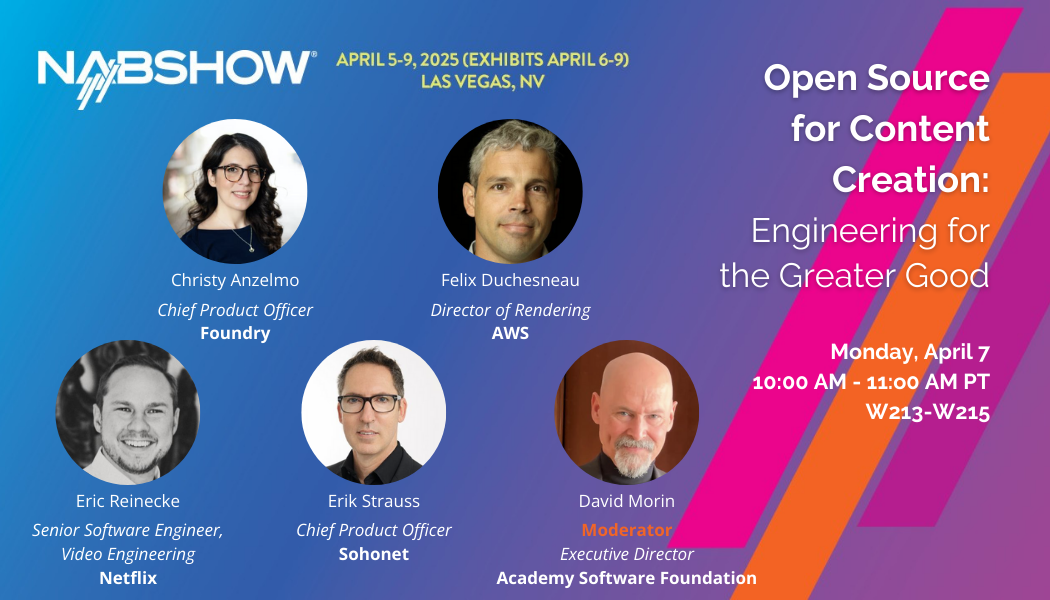
In July of 2019, Amazon Web Services (AWS) joined the Academy Software Foundation (ASWF) as a premier level member and has been an active participant ever since, helping execute on the Foundation’s mission to promote open source projects across the motion picture industry, improving the quality and quantity of those projects along the way. We recently caught up with AWS Thinkbox Senior Product Manager Bharathi (Batty) Muthukrishnan to ask about this history and recent developments.
How did AWS come to join the Academy Software Foundation?
The AWS path to the Academy Software Foundation can be traced back to 2017, when AWS acquired Thinkbox Software.
Our media and entertainment (M&E) customers were asking us for better ways to utilize AWS for cloud rendering and Thinkbox Software was an obvious value-add for AWS. In 2019, AWS acquired another VFX and animation centric company, Nimble Collective, which developed the initial technology behind Amazon Nimble Studio. As AWS continue growing the M&E teams, many of those people joining AWS were already involved with the Academy Software Foundation, and they continued to be involved so it was a natural move for AWS to join the Foundation. With the large variety of M&E workloads already running on AWS, this gave us the opportunity to contribute to ASWF projects and initiatives to help the community effectively use the cloud with open source technology and open standards. I myself joined the AWS Thinkbox team almost three years ago, and since then, I’ve worked on several major improvements to Thinkbox Deadline, as well as helped to make several Thinkbox plug-ins open source.
Why do you think that it’s important to support the Academy Software Foundation mission?
We believe that open source is good for everyone. We are committed to bringing the value of open source to our customers, and the operational excellence of AWS to open source communities. Since its inception, AWS has been the ideal place for customers to build and run open source software in the cloud, and AWS is proud to support open source initiatives. Additional details on our open source involvement can be found here.
Substantial advancements have already been made in open source technology, but there’s so much more to uncover, especially as workflows such as original camera negative to cloud become more commonplace. We look forward to our ongoing collaboration with the Academy Software Foundation community, our customers, and our partners to help shape next generation filmmaking.
What Thinkbox plug-ins did you help to open source? Why did you choose to open source those plugins now?
Customers are at the heart of every one of our decisions, and we listen closely when our customers tell us their problems. They operate under tight deadlines and have unique, proprietary pipelines. It became obvious that the best thing for our customers would be to open source AWS Thinkbox creative tools so that they could customize the software to meet their needs, add new integrations within their own timelines, fix bugs, and reduce dependency on our product release schedule. We started this process by open sourcing Krakatoa and XMesh for Autodesk Maya, then the plug-ins for 3ds Max. We’ve also open sourced Frost and Stoke for 3ds Max. This allows our customers to make more informed long-term decisions, because it allows them to develop the tools as they see fit.
What are some of the benefits AWS has experienced since becoming an Academy Software Foundation member?
When our customers win, AWS wins. We sell products and services to the VFX and animation industry, so standards and successful open source projects help AWS design better, more relevant products for our customers. If the industry standardizes around an Academy Software Foundation project, AWS can focus our efforts around that project to make more relevant and delightful experiences for our customers. Those customers benefit from the Foundation’s commitment to helping the M&E industry progress and standardize on formats, which enables them to share data and collaborate more easily on their increasingly large-scale projects.
Which Academy Software Foundation projects and groups does AWS help with and contribute to?
We recently open sourced the Noa Character set as part of the Digital Production Example Library (DPEL), where we help out on the Technical Steering Committee (TSC) as well. As a prime example of community standardization helping AWS deliver relevant products and features, we added Rez support to Deadline in 2022 and have improved on that implementation several times since then. We also have a contributor on the TSC of the Open Review Initiative, and are beyond excited for the developments and cloud capability that might come out of that group in the future. This summer we’re looking forward to our second year participating in the Academy Software Foundation’s Summer Learning Program, run by the Diversity and Inclusion Working Group. We’re hoping to have several mentors and speakers in the program this year, helping guide the next generation of industry professionals. Finally, as premier sponsors we also have a seat on the Academy Software Foundation’s board, and you’ll usually find several AWS team members in the Technical Advisory Committee meetings.
Any plans for open sourcing more AWS projects in the future?
Yes, but you’ll have to wait to find out exactly what!



